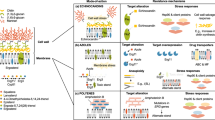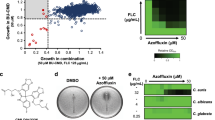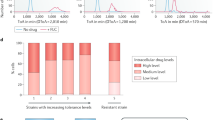Abstract
Drugs that act more promiscuously provide fewer routes for the emergence of resistant mutants. This benefit, however, often comes at the cost of serious off-target and dose-limiting toxicities. The classic example is the antifungal amphotericin B (AmB), which has evaded resistance for more than half a century. We report markedly less toxic amphotericins that nevertheless evade resistance. They are scalably accessed in just three steps from the natural product, and they bind their target (the fungal sterol ergosterol) with far greater selectivity than AmB. Hence, they are less toxic and far more effective in a mouse model of systemic candidiasis. To our surprise, exhaustive efforts to select for mutants resistant to these more selective compounds revealed that they are just as impervious to resistance as AmB. Thus, highly selective cytocidal action and the evasion of resistance are not mutually exclusive, suggesting practical routes to the discovery of less toxic, resistance-evasive therapies.
This is a preview of subscription content, access via your institution
Access options
Subscribe to this journal
Receive 12 print issues and online access
$259.00 per year
only $21.58 per issue
Buy this article
- Purchase on Springer Link
- Instant access to full article PDF
Prices may be subject to local taxes which are calculated during checkout




Similar content being viewed by others
References
Li, J. et al. Colistin: the re-emerging antibiotic for multidrug-resistant Gram-negative bacterial infections. Lancet Infect. Dis. 6, 589–601 (2006).
Cortes, J.E. et al. A phase 2 trial of ponatinib in Philadelphia chromosome–positive leukemias. N. Engl. J. Med. 369, 1783–1796 (2013).
Ellis, D. Amphotericin B: spectrum and resistance. J. Antimicrob. Chemother. 49, 7–10 (2002).
Brown, G. D. et al. Hidden killers: human fungal infections. Sci. Transl. Med. 4, 165rv13 (2012).
Volmer, A.A., Szpilman, A.M. & Carreira, E.M. Synthesis and biological evaluation of amphotericin B derivatives. Nat. Prod. Rep. 27, 1329–1349 (2010).
Ermishkin, L.N., Kasumov, K.M. & Potzeluyev, V.M. Single ionic channels induced in lipid bilayers by polyene antibiotics amphotericin B and nystatine. Nature 262, 698–699 (1976).
Gray, K.C. et al. Amphotericin primarily kills yeast by simply binding ergosterol. Proc. Natl. Acad. Sci. USA 109, 2234–2239 (2012).
Anderson, T.M. et al. Amphotericin forms an extramembranous and fungicidal sterol sponge. Nat. Chem. Biol. 10, 400–406 (2014).
Wilcock, B.C., Endo, M.M., Uno, B.E. & Burke, M.D. C2′-OH of amphotericin B plays an important role in binding the primary sterol of human cells but not yeast cells. J. Am. Chem. Soc. 135, 8488–8491 (2013).
Zhang, Y.-Q. et al. Requirement for ergosterol in V-ATPase function underlies antifungal activity of azole drugs. PLoS Pathog. 6, e1000939 (2010).
Heese-Peck, A. et al. Multiple functions of sterols in yeast endocytosis. Mol. Biol. Cell 13, 2664–2680 (2002).
Kato, M. & Wickner, W. Ergosterol is required for the Sec18/ATP-dependent priming step of homotypic vacuole fusion. EMBO J. 20, 4035–4040 (2001).
Klose, C. et al. Yeast lipids can phase-separate into micrometer-scale membrane domains. J. Biol. Chem. 285, 30224–30232 (2010).
Jin, H., McCaffery, J.M. & Grote, E. Ergosterol promotes pheromone signaling and plasma membrane fusion in mating yeast. J. Cell Biol. 180, 813–826 (2008).
Vincent, B.M., Lancaster, A.K., Scherz-Shouval, R., Whitesell, L. & Lindquist, S. Fitness trade-offs restrict the evolution of resistance to amphotericin B. PLoS Biol. 11, e1001692 (2013).
Palacios, D.S., Dailey, I., Siebert, D.M., Wilcock, B.C. & Burke, M.D. Synthesis-enabled functional group deletions reveal key underpinnings of amphotericin B ion channel and antifungal activities. Proc. Natl. Acad. Sci. USA 108, 6733–6738 (2011).
Neumann, A., Baginski, M. & Czub, J. How do sterols determine the antifungal activity of amphotericin B? Free energy of binding between the drug and its membrane targets. J. Am. Chem. Soc. 132, 18266–18272 (2010).
Matsumori, N., Sawada, Y. & Murata, M. Mycosamine orientation of amphotericin B controlling interaction with ergosterol: sterol-dependent activity of conformation-restricted derivatives with an amino-carbonyl bridge. J. Am. Chem. Soc. 127, 10667–10675 (2005).
Jarzembska, K.N. et al. Controlled crystallization, structure, and molecular properties of iodoacetylamphotericin B. Cryst. Growth Des. 12, 2336–2345 (2012).
Neant-Fery, M. et al. Molecular basis for the thiol sensitivity of insulin-degrading enzyme. Proc. Natl. Acad. Sci. USA 105, 9582–9587 (2008).
Duggan, K.C. et al. (R)-Profens are substrate-selective inhibitors of endocannabinoid oxygenation by COX-2. Nat. Chem. Biol. 7, 803–809 (2011).
MacPherson, D.T. et al. in Recent Advances in the Chemistry of Anti-infective Agents Vol. 119, 205–222 (Royal Society of Chemistry, 1993).
Power, P. et al. Engineered synthesis of 7-oxo- and 15-deoxy-15-oxo-amphotericins: insights into structure-activity relationships in polyene antibiotics. Chem. Biol. 15, 78–86 (2008).
Carmody, M. et al. Biosynthesis of amphotericin derivatives lacking exocyclic carboxyl groups. J. Biol. Chem. 280, 34420–34426 (2005).
Byrne, B., Carmody, M., Gibson, E., Rawlings, B. & Caffrey, P. Biosynthesis of deoxyamphotericins and deoxyamphoteronolides by engineered strains of Streptomyces nodosus. Chem. Biol. 10, 1215–1224 (2003).
Maeda, H., Suzuki, M., Sugano, H. & Matsumoto, K. A facile synthesis of (S)-isoserine from (S)-malic acid. Synthesis 1988, 401–402 (1988).
Palacios, D.S., Anderson, T.M. & Burke, M.D.A. Post-PKS oxidation of the amphotericin B skeleton predicted to be critical for channel formation is not required for potent antifungal activity. J. Am. Chem. Soc. 129, 13804–13805 (2007).
Bonner, D.P., Mechlinski, W. & Schaffner, C.P. Polyene macrolide derivatives. 3. Biological properties of polyene macrolide ester salts. J. Antibiot. 25, 261–262 (1972).
Keim, G.R. et al. Comparative toxicological studies of amphotericin B methyl ester and amphotericin B in mice, rats, and dogs. Antimicrob. Agents Chemother. 10, 687–690 (1976).
Tevyashova, A.N. et al. Structure-antifungal activity relationships of polyene antibiotics of the amphotericin B group. Antimicrob. Agents Chemother. 57, 3815–3822 (2013).
Paquet, V., Volmer, A.A. & Carreira, E.M. Synthesis and in vitro biological properties of novel cationic derivatives of amphotericin B. Chemistry 14, 2465–2481 (2008).
Pfaller, M. et al. Epidemiology and outcomes of candidemia in 3648 patients: data from the Prospective Antifungal Therapy (PATH Alliance®) registry, 2004–2008. Diagn. Microbiol. Infect. Dis. 74, 323–331 (2012).
Cruz, M.C. et al. Immunosuppressive and nonimmunosuppressive cyclosporine analogs are toxic to the opportunistic fungal pathogen Cryptococcus neoformans via cyclophilin-dependent inhibition of calcineurin. Antimicrob. Agents Chemother. 44, 143–149 (2000).
Lepak, A.J., Marchillo, K., VanHecker, J. & Andes, D.R. Posaconazole pharmacodynamic target determination against wild-type and Cyp51 mutant isolates of Aspergillus fumigatus in an in vivo model of invasive pulmonary aspergillosis. Antimicrob. Agents Chemother. 57, 579–585 (2013).
Ellis, J.K. et al. Metabolic response to low-level toxicant exposure in a novel renal tubule epithelial cell system. Mol. Biosyst. 7, 247–257 (2011).
Zager, R.A. Polyene antibiotics: relative degrees of in vitro cytotoxicity and potential effects on tubule phospholipid and ceramide content. Am. J. Kidney Dis. 36, 238–249 (2000).
Andes, D., Stamsted, T. & Conklin, R. Pharmacodynamics of amphotericin B in a neutropenic-mouse disseminated-candidiasis model. Antimicrob. Agents Chemother. 45, 922–926 (2001).
Pfaller, M.A. Antifungal drug resistance: mechanisms, epidemiology, and consequences for treatment. Am. J. Med. 125, S3–S13 (2012).
Sanglard, D., Ischer, F., Parkinson, T., Falconer, D. & Bille, J. Candida albicans mutations in the ergosterol biosynthetic pathway and resistance to several antifungal agents. Antimicrob. Agents Chemother. 47, 2404–2412 (2003).
Pfaller, M.A. et al. Wild-type MIC distributions and epidemiological cutoff values for amphotericin B, flucytosine, and itraconazole and Candida spp. as determined by CLSI broth microdilution. J. Clin. Microbiol. 50, 2040–2046 (2012).
Pinto, J.P., Machado, R., Xavier, J.G. & Futschik, M.E. Targeting molecular networks for drug research. Front. Genet. 5, 160 (2014).
Grongsaard, P. et al. Convergent, kilogram scale synthesis of an Akt kinase inhibitor. Org. Process Res. Dev. 16, 1069–1081 (2012).
Dailey, I. Synthesis and Function of the Conserved Motif of Mycosamine Containing Polyene Macrolides. PhD thesis,University of Illinois at Urbana-Champaign, (2012).
Kotler-Brajtburg, J. et al. Classification of polyene antibiotics according to chemical structure and biological effects. Antimicrob. Agents Chemother. 15, 716–722 (1979).
Moonis, M., Ahmad, I. & Bachhawat, B.K. Liposomal hamycin in the control of experimental aspergillosis in mice—relative toxicity, therapeutic efficacy and tissue distribution of free and liposomal hamycin. Indian J. Biochem. Biophys. 29, 339–345 (1992).
Hasper, H.E. et al. An alternative bactericidal mechanism of action for lantibiotic peptides that target lipid II. Science 313, 1636–1637 (2006).
Ling, L.L. et al. A new antibiotic kills pathogens without detectable resistance. Nature 517, 455–459 (2015).
Schneider, T. et al. Plectasin, a fungal defensin, targets the bacterial cell wall precursor lipid II. Science 328, 1168–1172 (2010).
Laganowsky, A. et al. Membrane proteins bind lipids selectively to modulate their structure and function. Nature 510, 172–175 (2014).
Han, X., Yang, K. & Gross, R.W. Multi-dimensional mass spectrometry-based shotgun lipidomics and novel strategies for lipidomic analyses. Mass Spectrom. Rev. 31, 134–178 (2012).
Pangborn, A.B., Giardello, M.A., Grubbs, R.H., Rosen, R.K. & Timmers, F.J. Safe and convenient procedure for solvent purification. Organometallics 15, 1518–1520 (1996).
Clinical Laboratory Standards Institute (CLSI). Reference method for broth dilution antifungal susceptibility testing of yeasts; approved standard, 3rd ed., CLSI document M27–A3 (Clinical and Laboratory Standards Institute, Wayne, PA, 2008).
Clinical Laboratory Standards Institute (CLSI). Reference method for broth dilution antifungal susceptibility testing of filamentous fungi; approved standard, 2nd edn. CLSI document M38–A2 (Clinical Laboratory Standards Institute, Wayne, PA, 2007).
Sebaugh, J.L. Guidelines for accurate EC50/IC50 estimation. Pharm. Stat. 10, 128–134 (2011).
Andes, D. & van Ogtrop, M. Characterization and quantitation of the pharmacodynamics of fluconazole in a neutropenic murine disseminated candidiasis infection model. Antimicrob. Agents Chemother. 43, 2116–2120 (1999).
Andes, D. & van Ogtrop, M. In vivo characterization of the pharmacodynamics of flucytosine in a neutropenic murine disseminated candidiasis model. Antimicrob. Agents Chemother. 44, 938–942 (2000).
Acknowledgements
Portions of this work were supported by the US National Institutes of Health (R01GM080436, R01GM080436-S), the Howard Hughes Medical Institute (HHMI) and the Mathers Foundation. M.D.B. is an HHMI Early Career Scientist, and S.L. is an HHMI Investigator.
Author information
Authors and Affiliations
Contributions
S.A.D. and M.D.B. conceived the study and oversaw design of synthesis, biophysical and several biological experiments. B.M.V., L.W. and S.L. designed resistance studies. D.R.A. designed mouse toxicity and efficacy studies. S.A.D. synthesized all of the compounds. B.M.V. executed all of the resistance studies. M.M.E. performed sterol binding and designed and performed cell toxicity assays. K.M. performed efficacy and toxicity studies in mice. S.A.D., B.M.V., S.L. and M.D.B. wrote the manuscript.
Corresponding authors
Ethics declarations
Competing interests
The University of Illinois has filed patents on compounds and chemistry reported herein. These have been licensed to REVOLUTION Medicines, a company for which M.D.B. is a founder.
Supplementary information
Supplementary Text and Figures
Supplementary Results, Supplementary Table 1, Supplementary Figure 1 and Supplementary Note (PDF 5329 kb)
Rights and permissions
About this article
Cite this article
Davis, S., Vincent, B., Endo, M. et al. Nontoxic antimicrobials that evade drug resistance. Nat Chem Biol 11, 481–487 (2015). https://doi.org/10.1038/nchembio.1821
Received:
Accepted:
Published:
Issue Date:
DOI: https://doi.org/10.1038/nchembio.1821
This article is cited by
-
Tuning sterol extraction kinetics yields a renal-sparing polyene antifungal
Nature (2023)
-
Mechanistic insight into the role of mevalonate kinase by a natural fatty acid-mediated killing of Leishmania donovani
Scientific Reports (2022)
-
Targeting fungal membrane homeostasis with imidazopyrazoindoles impairs azole resistance and biofilm formation
Nature Communications (2022)
-
Towards the generalized iterative synthesis of small molecules
Nature Reviews Chemistry (2018)
-
Nystatin-like Pseudonocardia polyene B1, a novel disaccharide-containing antifungal heptaene antibiotic
Scientific Reports (2018)



